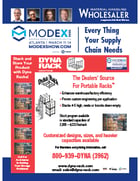 Joe Lyden
Joe Lyden At what cost? Evaluating and improving Back Injuries from pushing in industrial settings
As the expression goes, nothing in life is free. Measuring the cost of something, however, isn’t always clear. Does it cost time, money, productivity, confidence or something else? When it comes to industry, not protecting the health of our employees, specifically the health of the lower back, has many costs.
For example, lower back injuries are estimated to account for a total annual cost of over 100 billion dollars in the U.S. alone. Identifying the major costs of lower-back injury from pushing in industrial settings and finding ways to prevent these injuries can reduce the overall cost to your company.
Physical injury
The most obvious cost of lower-back injuries in companies is the suffering of and effects on valued employees. No company should sacrifice the back health of its employees for any reason. Once a back injury has occurred, an employee has to live with the lower back injury whether they are at work or not.
Many back injuries go away after a few weeks. However, if the injury does not go away after six weeks, they may have a disability for life. Chronic back injuries are notoriously difficult to treat. Surgery is effective around 50% of the time, so you might be rolling the dice with surgery. If you have an MRI or a CT scan, doctors can only tell what is wrong with your back 10% to 15% of the time.
Because back injuries can be so difficult to treat, employees may suffer a lifetime of pain and limitations because of that injury, while at the same time, their family and friends are also affected by their injury. This is a great responsibility and a high cost.
Employee retention
Employee retention models are not always simple, but when a company has a history of bad working conditions, employees will not stay. There are many ways that low customer retention slows the advancement of your company. The costs come from hiring, onboarding, lost productivity, lost engagement, training costs, cultural impact, and the inability to innovate because companies are constantly getting employees up to speed. Overall, your company cannot maximize its profits, because it is moving in a circle. Even if your company as a whole is profitable, it is losing money unnecessarily.
For example, let’s say you hire a new employee to assemble parts and move them around. This employee is unable to move at the rate that they will when they are fully integrated. This employee will become more versatile and valuable over time.
There are intangible disadvantages that will only be reflected in the lower profitability of the company, even if a company is profitable overall. In fact, retraining employees normally varies from tens of thousands of dollars to somewhere in the neighborhood of 1.5 to 2 times that employee’s annual salary.
Financial
Workers’ comp claims for back injury are on average $40,000 to $80,000 per employee. Employee retention costs as stated above are most often in the tens of thousands of dollars. In 2004, 186.7 million workdays were lost to back pain, and in 2018, manufacturing had a total of 430,300 injuries and illnesses reported by the Bureau of Labor Statistics. These days lost all affected individual companies financially.
To account for days missed, OSHA has set up an injury/cost estimator. For example, consider that your company lost $264,434 to back injuries. In order to break even, your company would have to make $8,818,466. In other words, by preventing these injuries, you would have a 3,300% return on your investment. Preventing these back injuries in the first place is the best way to reduce these numbers. That means addressing the issues around pushing a cart.
Pushing weight thresholds
The goal of every organization where pushing is involved should be to reduce the force that an employee must exert when pushing. The name of this force is commonly referred to as push/pull, and the vast majority of the time in industrial settings, employees generate push/pull by pushing a cart of some sort. That means that companies reduce injuries and costs by reducing push/pull forces on these carts.
All things being equal, we want to reduce push/pull as much as possible, but when you or an employee regularly moves thousands of pounds, you can only reduce push/pull by so much. Because push/pull is not going to be zero, our goal should be to make sure that our employees are not in danger. That means that we need guidelines for weight thresholds that will predict the likelihood of injury at certain weights and for specific people.
The most recent weight thresholds guidelines are from the Ohio State University Spine Research Institute in collaboration with the Ohio Bureau of Workers’ Compensation. This tool allows you to add action, type of exertion, force recorded, and hand height. Then, it will tell you if this task is safe for 80% of the general population. Each person has different capabilities and limitations, but these guidelines will estimate accurately for most people. If your task is deemed “safe,” then you are in pretty good shape.
Push/pull measurement guidelines
In order to calculate the safety of a pushing or pulling activity with the guidelines above, most variables are straightforward, for example hand height. Push/pull force is not as straightforward. To get the force, we need to use a gauge—most often a hand-held force gauge. However, the force that a person exerts normally does not stay the same, because varying speed over distance can dramatically change push/pull force measurements. For example, we have conducted tests where we have gotten ten times higher or lower push/pull readings, based off of the speed at which we pushed the cart.
The solution is to use a standard speed and distance guideline. In a recent study, the Spine Research Institute determined that the speed that most accurately predicts injure risk to an employee is 1 meter/3 seconds initially and 0.5 meter/second sustained. Using this speed, you will be able to get accurate push/pull force, which you can then add into the OBWC’s tool to make sure that your employees are safe.
If the OBWC tool determines that your activity is too dangerous, then you need to reduce weight or change your equipment to more ergonomic versions that allow you to lower your push/pull, while carrying this heavier weight. There are a few ways to accomplish this.
Ergonomic Equipment
First, make sure your carts are optimized, particularly the handle height. A higher handle height is preferred to one that is too low, and your handle should allow you to push with the proper hand separation and placement, with two hands. Your cart should also be flexible with respect to the wheels that it can support—some carts will not allow certain sizes and configurations of casters.
The second way to improve push/pull force is the casters you select. Both the caster wheel and rig are critical to reducing push/pull because casters are the only component touching the ground in a pushing movement. Casters have quite a few characteristics that can make a huge difference.
For example:
- Rebound resilience: the bounciness of the wheel
- Durometer: the hardness of the wheel
- Caster diameter: the bigger it is, the easier it is to push
- Caster lead: the angle of the rig fork
- Bearing quality: the higher the quality, the less rolling resistance
When you match the optimum qualities of your caster to your facility conditions, you can improve your push/pull force dramatically and therefore reduce back injuries.
Companies can have significant costs from personnel, marketing, purchasing, engineering, management, etc. However, the costs of lower back pain from pushing injuries are one cost that we can improve significantly by evaluating the various costs, getting proper guidelines, and improving push/pull with the proper equipment.
About the Author:
Joe Lyden is the president of Caster Connection, a manufacturer of casters and wheels, based in Columbus, Ohio.









